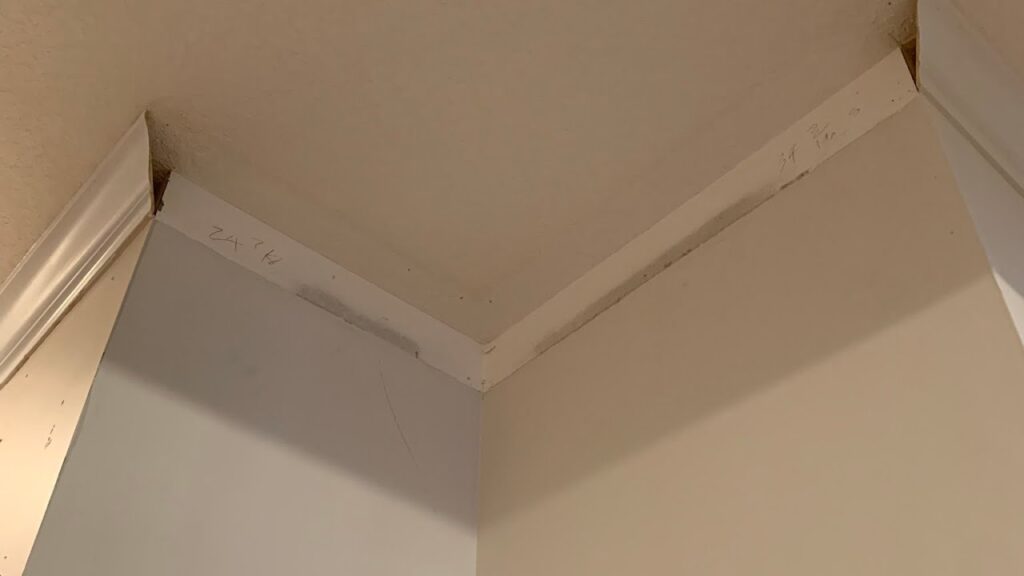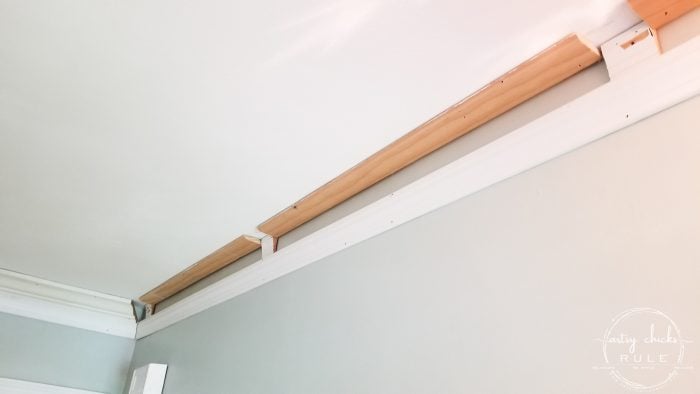In this article, you will learn all about removing crown molding and whether or not it’s something you can do yourself. We will walk you through the step-by-step process, giving you helpful tips and tricks along the way. By the end, you’ll have a clear understanding of what it takes to successfully remove crown molding and decide if it’s a DIY project you’re comfortable tackling. So let’s get started and empower you with the knowledge and confidence to take on this home improvement task!

Preparing to Remove Crown Molding
Inspect the crown molding
Before you begin removing crown molding, it’s important to inspect it. Look for any signs of damage or wear that may affect the removal process. Check for any loose or missing screws, nails, or adhesive. Additionally, assess the condition of the wall underneath the molding to ensure no repairs are needed prior to removal.
Gather the necessary tools
To successfully remove crown molding, you’ll need a few essential tools. These include a pry bar or putty knife, a hammer, a reciprocating saw, a utility knife, a heat gun or hair dryer, safety glasses, and gloves. Having these tools ready and easily accessible will make the removal process easier and more efficient.
Protect the surrounding area
Before you start removing the crown molding, it’s important to take steps to protect the surrounding area. Cover any furniture, flooring, or nearby surfaces with drop cloths or plastic sheets to prevent any damage from falling debris or dust. This will also make the cleanup process much easier once the crown molding has been removed.
Removing Crown Molding
Start at one end of the molding
To begin removing the crown molding, start at one end and carefully insert the pry bar or putty knife between the molding and the wall. Gently apply pressure to create a gap between the molding and the wall. Be cautious not to use excessive force, as this may damage the wall or the molding itself.
Use a pry bar to gently remove the molding
Once you have created a gap between the molding and the wall, use a pry bar or putty knife to slowly and gently pry the molding away from the wall. Start at the corner and work your way along the length of the molding, repeating this process at regular intervals. Take your time to ensure the molding is being removed evenly and without causing any damage.
Slowly work your way along the length of the molding
As you continue removing the crown molding, be sure to work your way along the length of the molding gradually. Use the pry bar or putty knife to carefully pry the molding away from the wall, moving along a few inches at a time. By taking your time and using gentle pressure, you’ll minimize the risk of damaging the wall or the molding during the removal process.
Dealing with Stubborn Crown Molding
Apply heat to loosen the adhesive
In some cases, the crown molding may be stubbornly adhered to the wall, making it difficult to remove. If this is the case, you can use a heat gun or hair dryer to apply heat to the molding. This will help soften any adhesive or caulk, making it easier to pry the molding away from the wall.
Score the edges of the molding
If the crown molding is still not budging after applying heat, you can use a utility knife to score the edges of the molding. Carefully run the knife along the top and bottom edges of the molding, creating small incisions. This will help weaken the bond between the molding and the wall, making it easier to remove.
Use a reciprocating saw
If all else fails and the crown molding still refuses to come off, you can use a reciprocating saw as a last resort. Insert the saw blade between the molding and the wall and carefully cut through the adhesive or nails holding the molding in place. Be cautious not to damage the wall underneath the molding while using the saw.
Repairing the Wall
Fill any nail or screw holes
After successfully removing the crown molding, you may notice nail or screw holes in the wall. Fill these holes with spackle or putty, ensuring a smooth and even surface. Allow the filler to dry completely before moving on to the next step.
Smooth out any rough spots
Once the nail or screw holes have been filled, inspect the wall for any rough spots or imperfections. Use sandpaper or a sanding block to carefully smooth out these areas, creating a seamless finish. This step is crucial before applying any touch-up paint or wallpaper.
Touch up the paint or wallpaper
After repairing the wall and ensuring a smooth surface, it’s time to touch up the paint or wallpaper. Match the existing color and texture as closely as possible to achieve a seamless and professional-looking result. Apply the paint or wallpaper in thin, even coats, allowing each layer to dry before applying the next.

Safety Precautions
Wear protective eyewear
When removing crown molding, it’s important to prioritize your safety. Always wear protective eyewear, such as safety glasses, to shield your eyes from any potential flying debris or dust. This will help prevent eye injuries and ensure a safe working environment.
Use caution when working on a ladder
If the crown molding is located in a high area, you may need to use a ladder for accessibility. Exercise caution when working on a ladder and ensure it is stable and secure. Always maintain three points of contact with the ladder, such as two feet and one hand, to prevent falls or accidents.
Turn off the power before removing crown molding near electrical fixtures
If the crown molding is surrounding electrical fixtures, such as light switches or outlets, it’s crucial to turn off the power before removing the molding. This will help prevent any electrical accidents or injuries during the removal process. Consult a professional electrician if you’re unsure of how to safely disconnect the power.
Common Mistakes to Avoid
Using excessive force when removing the molding
One common mistake when removing crown molding is using excessive force. Applying too much pressure or prying too aggressively can result in damage to the wall or the molding itself. Take your time, be patient, and use gentle pressure when removing the molding to ensure a smooth process.
Not properly supporting the molding during removal
Another mistake to avoid is not properly supporting the molding during the removal process. If the molding is long or heavy, it’s important to have someone help support it as you remove it from the wall. This will prevent any unnecessary strain on the molding and minimize the risk of accidents or damage.
Not following proper safety protocols
Ignoring or overlooking safety precautions is a serious mistake when removing crown molding. Always wear protective eyewear, exercise caution when working on a ladder, and ensure the power is turned off near electrical fixtures. By following these safety protocols, you’ll reduce the risk of accidents or injuries during the removal process.

Tips for Success
Take your time
Removing crown molding requires patience and precision. Take your time and work slowly and carefully to ensure a smooth and successful removal process. Rushing or applying excessive force can result in damage to the wall or the molding, so be patient and thorough.
Label the pieces of molding
If you plan on reusing the crown molding or need to keep track of the pieces for any reason, it’s helpful to label them. Use small stickers or masking tape to mark each piece with its corresponding location. This will make the reinstallation process easier and less confusing.
Seek professional help if needed
If you’re unsure about any aspect of removing crown molding or encounter any difficulties during the process, don’t hesitate to seek professional help. A contractor or handyman with experience in crown molding removal can provide guidance and expertise to ensure a successful outcome.
Conclusion
Removing crown molding can be a DIY project with the proper preparation and tools. By inspecting the molding, gathering the necessary tools, and protecting the surrounding area, you can embark on the removal process confidently. Deal with stubborn crown molding by applying heat, scoring the edges, or using a reciprocating saw if necessary.
After the crown molding is successfully removed, take the time to repair the wall by filling any holes, smoothing out rough spots, and touching up the paint or wallpaper. Always prioritize safety by wearing protective eyewear, using caution on ladders, and turning off the power near electrical fixtures.
To ensure a successful removal process, avoid common mistakes such as using excessive force, not properly supporting the molding, and neglecting safety protocols. Take your time, label the pieces of molding if needed, and seek professional help if you encounter any challenges.
By following these steps and tips, you can confidently remove crown molding and achieve the desired results. Take pride in your DIY accomplishment and enjoy the new look of your space without crown molding.
